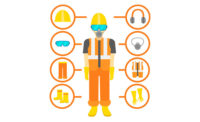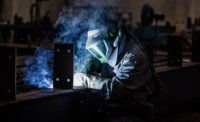Professional welding can be one of the lucrative and rewarding fields but the welders persistently at risk on the job. Welders are exposed to high temperatures and electrical current for several hours of every day. Therefore, proper safety is a must and finding the best safety equipment is the key.
Providing the right protective equipment to welders that is usable, comfortable and of the highest quality is essential. In recent years, welding has been experiencing a lot of new technological innovations, shaping up the industry for big changes. The latest innovations have enabled the welders to work safely without losing efficiency.
Wearable technology
The number of wearable devices is available for the safety of welders and prevention of accidents at work. Welding robots have been successful in grabbing attention due to increasing industry demand and competitive prices. Robotic exoskeletons have been helping the workers by reducing fatigue, injuries, and medical costs. They have also enhanced the quality of work by improving alertness and productivity.
Laser welding
Laser welding technology is used to weld a wide range of materials, especially those with higher melting points and heat conduction. High precision, flexibility, and productivity are offered by laser welding. This has further helped in mass production. Demand for laser welding is mostly from medical device technology, entertainment electronics and photovoltaics. Other sectors such construction and automotive are also contributing to the demand for laser welding the equipment.
Welding curtains
There are several products that can be used for safety purposes within a welding area and one of the most successful and versatile is welding curtains. Here are some of the advantages of welding curtains:
Reduces noise: The noise produced by welding can be damaging to both workers and those in the building. To avoid such damaging noise, the welders use earplugs to protect their hearing from the loud sounds of metal grinding. However, noise produced from welding areas can certainly distract employees working in the other sections of the building away from where the welding activities take place. Welding curtains can minimize the risk of ear damage and overall irritation to employees working nearby.
Protection: Welders often wear safety gears such as eye protection and heat resistant clothing. However, people outside of the area may be vulnerable to a number of different injuries. For instance, bright light created by the weld can cause serious damage to eyesight if looked at it directly. Welding curtains serve as a barrier and prevent any sort of injuries. Creating a well-defined welding area ensures that welders and other nearby employees are protected.
Controls temperature: Welding can produce flames that heat up to 6,300 degrees F, which can be dangerous and put those around the area at a greater risk. Welders protect themselves from the heat by wearing the appropriate clothing, but other employees near the facility might not. Welding curtains help in withstand extreme heat. Furthermore, these screens aid in reducing risk associated with heat levels while keeping everyone in the building safe from harm.
Safety requirements
It is understood that no two welding operations have the same requirements. Just like the processes, equipment, and required welder skill set vary, the company’s safety requirements must also be upgraded and should be considered as the top priority. Positive effects on production and implementation of safety regulations are possible only when the right precautions are taken to protect welders.
Here are three key steps that support in creating safe, clean and comfortable welding environment:
Hazard assessment: To uncover the problematic areas within the facility, performing hazard assessments is essential. This practice not only encourages both managers and welders to pay closer attention to safety details that may otherwise go unnoticed but it also provides a better understanding of the welding environment. Additionally, it is also necessary to engage employees in hazard assessments by reviewing recordable injuries and trends with potential safety risks and then take appropriate action to make corrections.
Training: The changes that are implemented after assessing the hazards must be well-communicated to welders. Training the employees appropriately on the changes implemented can definitely contribute to a safe and comfortable welding environment. As per OSHA’s standards, the training topics must include:
- Review of the hazard assessment process, as well as the findings and action items.
- The OSHA regulations pertaining to the hazard found and solutions that address it.
- How to use safety products or processes in routine and emergency situations.
- Proper maintenance practices for all safety equipment.
Communication: Sharing the changes, improvements and findings with management and welders is crucial as it encourages employee involvement, strengthens relationships within the organization, and also helps in evaluating the safety initiatives consistently. Stronger communication among management and employees leads to greater sense of purpose.
Every industry changes a lot, month after month, year after year. Industry professional’s job is to keep up with the trends. A safe work environment can save you money by reducing liabilities and helps in retaining the welders, too. Creating safer welding environment and sustaining it is possible only if the employees are directly involved in the efforts.
References:
- Importance of Safety Gear for Welding. (2018, January 19). https://ishm.org/importance-safety-gear-welding/
- Kemper America. (2015, March 05). The Importance of Welding Safety. https://kemperamerica.com/the-importance-of-welding-safety/
- Buel, Z. (2018, May 08). 3 Welding Industry Trends You Need to Be Aware Of. https://www.weldingschool.com/blog/welding/3-welding-industry-trends-you-need-to-be-aware-of/



